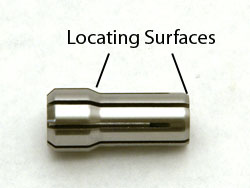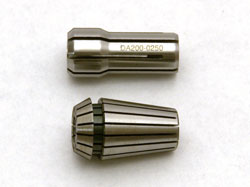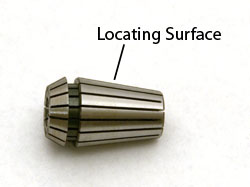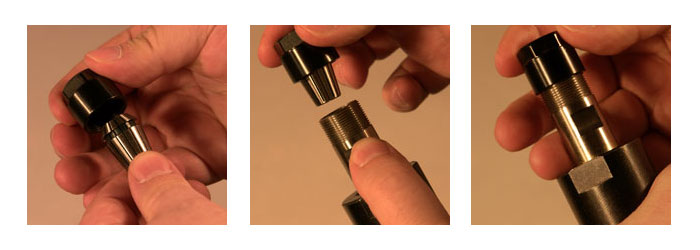
ER Collets
A new style of collet is featured on the new Top Cat tools that greatly surpass all previous collets in durability, accuracy and ease of tightening. These new collets are the single angle, ER series collets. In this article we hope to give you a bit of background on collet systems and a primer on how to use them to their fullest potential.
The History

The collet inserts you are most like to find in industrial quality air tools are of the double angle style. These collet assemblies are identified by having two short, angled surfaces that locate the collet insert in the collet body. As the collet nut is tightened, the insert is pushed back into the body against these two angles. The insert slides along them, collapsing and grabbing onto the mandrel.
How is an ER different?

ER series collet assemblies are the collets of choice for all of the high end machining applications. The collets are characterized by having one long, shallow-angled locating surface. The system works much like the double angle in that the collet nut pushes the insert's angled surface into the body's angled surface and the insert then collapses on the mandrel.
But what is the advantage?

The advantages of the ER system are many:
1. One angled surface is more effective than two when dirt and wear are present. A double angle collet system requires that both the collet body and the insert have the exact same length between the angled faces or it will not tighten evenly. As parts wear or get a bit dirty, one angled surface may begin tightening before the other. This leads to decreased clamping force and increased runout. A single angle collet only has one surface to worry about. As the insert or the body wear, they just move closer together. There is no position between two places that must be perfect for the system to work.
2. Long surfaces last longer. The double angle system has two very short angles that do all of the locating. These angled surfaces are what take all of the force and wear when tightening the collet system. The ER system, however, has a very long surface with which to spread the force. More area equals less pressure which equals less wear which equals longer life.
3. Shallow angles tighten better. The angle used in a double angle collet system is relatively steep at around 22 degrees. The problem with such a steep angle is that not much of your tightening of the nut goes into the securing of the mandrel in the insert. If you make this angle shallower, a wedging effect takes hold, greatly increasing the clamping force that the insert is able to produce. The ER series utilizes an 8 degree angle which increases clamping force by almost 3 times using the same amount of torque on the nut.
4. The ER system has a retainer that keeps the nut and the insert together. One of the biggest problems with any collet system (or really anything that you have to take off of a tool) is that there are little parts to lose. The ER collet insert has a groove that matches up to a ring in the collet nut. These two pieces snap together leaving you with fewer parts to keep track of.
Tips on using an ER collet system
1. Do not take the collet nut completely off the tool with each burr change. Unless you are cleaning out the collet body there is no reason to disassemble the nut and insert assembly. By leaving the nut on the tool you keep it sealed up from letting in stray debris, lessen the problems of cross-threading the nut back on and you have a better chance at not losing it.
2. Snap the collet insert into the collet nut before screwing the nut onto the collet body. If you put the collet insert into the body and then screw on the nut you run the risk of crushing the insert and you may have problems prying it out again.

3. Keep the system clean. Ground debris is the biggest enemy your collet system has. When debris gets caught between the body and the insert both can be damaged and the accuracy of the whole system can be lost.
4. Do not tighten an empty collet assembly. This can make the insert collapse more than its design and can damage it.
